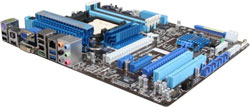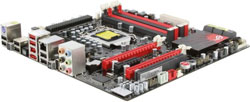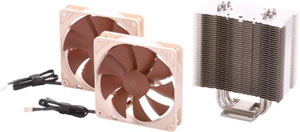Holiday 2010 System Builder's Guide
by AnandTech Staff, edited by Jarred Walton on November 19, 2010 2:00 AM EST- Posted in
- Guides
- Systems
- Holiday 2010
Raja's Midrange Overclocking Systems
What about building a bang-for-the-buck overclocking experience, you ask? As our resident overclocking guru and motherboard reviewer, Raja has more experience with this area than the rest of us so we turned this section over to him. In order to keep things simple, we kept nearly all of the components in Vivek's midrange build but switched out the motherboard, processor, RAM and PSU. We also added an aftermarket cooler to allow the CPUs to reach their full potential. Here's what Raja put together. [Ed: Text by Jarred, most of the picks by Raja.]
| Raja's Midrange AMD Overclocking System | ||
| Hardware | Component | Price |
| Processor |
AMD Phenom II X6 1055T (Thuban 45nm, 2.8 to 3.3 GHz, 6x512KB L2, 6MB L3, 125W |
$179 |
| Motherboard | ASUS M4A89GTD Pro (AMD 890GX AM3) | $135 |
| CPU Cooler | Noctua NH-U12P SE2 120mm SSO | $60 |
| Video | ASUS Radeon HD 6850 1GB (EAH6850) | $200 |
| Memory | G.Skill 2x2GB DDR3-1600 (F3-12800CL9D-4GBNQ) | $65 |
| Hard Drive | WD Caviar Blue 1TB (WD10EALS) | $70 |
| Optical Drive | ASUS 24x DVDRW (DRW-24B1ST) | $20 |
| Power Supply | Seasonic S12II 620W Bronze (80 Plus Bronze) | $75 |
| Case | Antec Nine Hundred Two | $89 |
| Total System Price | $893 | |
For AMD overclocking, I chose one of the hex-core Thuban CPUs, just so you can get every last ounce of performance out of AMD's architecture. The ASUS motherboard ended up being our top AM3 overclocking selection--at least when keeping prices in check--and is good for up to a 50% overclock by raising the base clock. Thuban will  generally top out in the 4.0-4.2GHz range, making this board a perfect fit. The Noctua cooler will help keep things cool without making a ton of noise, and the Seasonic S12II 620W power supply should deliver clean, stable current to the system.
generally top out in the 4.0-4.2GHz range, making this board a perfect fit. The Noctua cooler will help keep things cool without making a ton of noise, and the Seasonic S12II 620W power supply should deliver clean, stable current to the system.
Alternately, if you want to spin the wheel, you can also try your hand at core unlocking and save some money. $100 will buy you the Phenom II X2 560 Black Edition, which has two disabled cores. The ASUS board allows core unlocking, provided your CPU can handle it. Many users have had success with core unlocking, but there's no guarantee, and you'll never get the six cores that Thuban processors offer.
Our memory kit may not look like much, with its DDR3-1600 speed and CAS 9 timings. In reality, it shouldn't limit you but it's getting tricky to determine which memory to buy for overclocking. Vendors are now covering up their IC choices so much it's difficult to know what's inside; what we're looking for is an Elpida BBSE type variant or a similar IC from PSC. The G.Skill kit should work, but YMMV.
| Raja's Midrange Intel Overclocking System | ||
| Hardware | Component | Price |
| Processor |
Intel Core i5-760 Lynnfield 45nm (4x2.8GHz to 3.33GHz Turbo, 8MB L3, 95W) |
$200 |
| Motherboard | ASUS Maximus III GENE (Intel P55 1156) ($20 MIR) | $127 |
| CPU Cooler | Noctua NH-U12P SE2 120mm SSO | $60 |
| Video | ASUS Radeon HD 6850 1GB (EAH6850) | $200 |
| Memory | G.Skill 2x2GB DDR3-1600 (F3-12800CL9D-4GBNQ) | $65 |
| Hard Drive | WD Caviar Blue 1TB (WD10EALS) | $70 |
| Optical Drive | ASUS 24x DVDRW (DRW-24B1ST) | $20 |
| Power Supply | Seasonic S12II 620W Bronze (80 Plus Bronze) | $75 |
| Case | Antec Nine Hundred Two | $89 |
| Total System Price | $906 | |
Okay, first let's get this out of the way: Sandy Bridge is right around the corner. Think your hopped up i5-760 overclock is impressive? Imagine an unlocked Sandy Bridge chip running at 4.3-4.5GHz on air cooling. If you're into Intel overclocking, we'd really consider just waiting a bit longer right now. But, if you must buy a P55 system right now and you want a good overclock....
For the CPU, the i5-760 remains the most sensible choice. Priced at $200, you still get four cores with great overclocking potential--hitting 4.0-4.2GHz is generally common with an appropriate motherboard and cooling. The jump to i7-870 is $80 and all you really get is Hyper-Threading, since maximum  overclocking means you'll want to disable the Turbo Boost feature and most of the Lynnfield CPUs are going to top out around the same 4.2GHz. We might be swayed to make an investment in Core i7 if it weren't for Sandy Bridge; then again, there's an upside: motherboards that used to push nearly $200 have come down quite a bit and there are plenty of rebates going around right now.
overclocking means you'll want to disable the Turbo Boost feature and most of the Lynnfield CPUs are going to top out around the same 4.2GHz. We might be swayed to make an investment in Core i7 if it weren't for Sandy Bridge; then again, there's an upside: motherboards that used to push nearly $200 have come down quite a bit and there are plenty of rebates going around right now.
The motherboard is always a critical component for overclocking, and even though there are plenty of options that can do well, we wanted something more than just a decent overclock. The ASUS Maximus III GENE can easily hit BLCKs far beyond what you'll need for an i5-760, but even better is the excellent voltage regulation that will allow you to push 4GHz and higher without pumping a ton of current through your CPU. ASUS also makes overclocking very easy on the less experienced, with only minor tweaks necessary to get your system running at top speed.
Cooling for both systems comes courtesy of the Noctua NH-U12P SE2, a high quality push-pull cooler capable of keeping your CPU temperatures down without raising noise levels.  While there are decent coolers for a bit less money, we've never been disappointed by the Noctua; it works well even with hex-core processors if you move to X58, so the Lynnfield CPUs aren't going to be a problem.
While there are decent coolers for a bit less money, we've never been disappointed by the Noctua; it works well even with hex-core processors if you move to X58, so the Lynnfield CPUs aren't going to be a problem.
You'll notice that the power supply isn't the OCZ model Vivek used; instead the PSU is a higher quality Seasonic S12II capable of delivering the clean, stable power you'd want in an overclocked system. If you want to move to dual graphics cards and a heavily overclocked CPU, the 620W power supply should still keep up with everything short of the fastest GPUs. If that's what you'd like, I suggest looking at Ryan's X58 high-end SLI build.










112 Comments
View All Comments
JarredWalton - Friday, November 19, 2010 - link
While it would be great if Bulldozer could run in current motherboards, all the information I've been able to gather (including asking a contact at a motherboard manufacturer) is that Bulldozer for desktops will run in AM3r2. That socket will be similar to AM3, and it will be able to accept and run current AM3 processors, but the reverse isn't true. So, in essence it's the AM2+ situation again.If you search AMD's site, there's no mention of AM3r2 that I can find outside of their forums. It's still possible that we're mistaken, but AMD hasn't unequivocally stated that "yes BD will work in current motherboards" so I wouldn't count on it. I think originally the idea was to try and make it happen, but now it's not guaranteed.
If you really want to go to the rumor mill, BD might actually work in current boards but might blow caps or have reduced performance. Maybe someone will come out with a fix. All indications however are that there will be new chipsets (980/990 most likely), a new socket requirements, etc. I guess it may be a lot like the socket 775 transitions from Intel where we had a few manufacturers that got older 945P chipsets to run Core 2 and such.
JarredWalton - Friday, November 19, 2010 - link
Just to add a bit more: Phenom X6 will technically work in many 790FX motherboards... but it's not the same as running it in an 890FX. 790FX wasn't designed for Turbo Core, it has some power management issues with Thuban, etc. We have seen similar issues with previous updates where a CPU would work, but it didn't perform optimally. We may see that with Bulldozer as well, where it will run in 800 series boards with a BIOS update but it very likely will run best with a new motherboard/chipset. If AMD and their partners can prove me wrong, I'd be very pleased, but based on at least one source I'm not holding out much hope.blotto5 - Saturday, November 20, 2010 - link
thanks for the info good to know since im running a phenom x6 in a 790fx mobo but i think im going to wait to buy a new mobo because of this talk of a new socket a la am2 to am2+baba264 - Friday, November 19, 2010 - link
This comes quite handy as after the death of my graphic card two days ago, I was seriously thinking of buying a new system that would be quite similar to "Ryan's High-End Gaming System".However, when I had previewed the various parts I wanted, I had set my mind on a new lynnfield core with an i7 870 rather than the old Bloomfield core. Since I don't plan to upgrade to an SLI setting I thought that the i7 870 was the best choice of processor (for the price), was I mistaken?
Anyway, thanks for the article, this article really comforts me in what I meant to buy.
Ryan Smith - Friday, November 19, 2010 - link
The 870 is quite good. In fact when I was putting that list together I was seriously considering that instead of an X58 platform. The clincher was SLI support (P55 boards with SLI quickly drive the price up); but since you're not going to be using SLI I wouldn't be concerned.mapesdhs - Friday, November 19, 2010 - link
P55 boards run very nicely SLI, easily outperforming X58 boards, and that's
with an 860, never mind an 870. See my results pages:
http://www.sgidepot.co.uk/misc/pctests.html
http://www.sgidepot.co.uk/misc/stalkercopbench.txt
Further tests coming soon with an 870 + GTX 460 FTW SLI.
it's only really 3-way SLI where X58 takes over. For 2-way, the speeds
are just as good (if not better) and the costs are significantly lower - the
board I'm using costs less than 70 UKP ($110).
Ian.
JarredWalton - Friday, November 19, 2010 - link
Color me confused, but those links don't seem to provide the data you're talking about. The question is how something like i7-930 with X58 compares to i7-860 with P55 while everything else is kept constant, and all the stuff there looks like 930 + 4870 CF or 460 SLI, and 860 + 8800 GT SLI, or some other sets of data. You'd need to show X58 460 SLI vs. P55 460 SLI to "prove" that P55 is "easily outperforming X58 boards". And if you do everything with similar quality components, the X58 ought to win out by virtue of having two x16 connects compared to two x8 connects on P55.mapesdhs - Friday, November 19, 2010 - link
(my friend has 4890s, not 4870s)
I'm surprised you'd say that given existing articles have already
shown that SLI doesn't need full 16x to perform nicely. Some games
need it because they're written badly (FSX), but others run perfectly
well at 8X, or even 4X.
Specific data coming soon (still testing) but my point was that the
existing data already shows the same effect - people on forums
said the 4890s should win, but they don't much of the time except
where resolution, etc. are a factor.
I'm still ploughing through my P55/460 tests. All takes time as I'm
sure you can appreciate. :)
Ian.
JarredWalton - Friday, November 19, 2010 - link
I'm not saying X58 is substantially faster by any means; I'm just saying that all things being equal there's no reason P55 should be faster. x8 vs. x16 isn't a huge benefit, but especially with higher clocked CPUs and more powerful GPUs (i.e. GTX 580 or HD 5870) the X58 should come out ahead. Anyway, Gary Key did a pretty direct comparison when he was still with us:http://www.anandtech.com/show/2847
In general X58 CF is better than P55 CF, though the margin is never so large as to be alarming. What Gary doesn't show is how the SLI setups compare (probably for lack of an SLI capable P55 board at the time he was with us). I'd figure they're also similar. All told, P55 is faster for single GPUs, but the x8+x8 dual-GPU configuration should and usually does incur a small performance hit.
mapesdhs - Saturday, November 20, 2010 - link
Generally true, though remember the one advantage which
can make a difference sometimes (and push it in favour
of P55) is the better Turbo on the 870, etc. For fixed
clocks, have a look at the CPU scores I get with the
860 at 4018 for the 3DMark06 CPU tests, compare to
my friend's 930 at 4136 (and btw, it's not RAM speed;
I lowered my RAM to match, scores only dropped 1
or 2%).
You're right though about the top-end cards/CPUs, if
I was playing at crazy res with expensive cards like
the 580 then X58 would be more logical. For midrange
though, like the 460 (with or without SLI), the gain from
X58 is minimal at best - the cost difference (which
may be large) can be used to have a better GPU,
widening the gap further.
And by cost difference I mean, for example, the Asrock
P55 Deluxe, which is now as cheap as 68 UKP here.
It has excellent slot spacing for SLI, ie. better cooling.
Either way, we shall see; after doing default tests, my
plan is to run the FTWs at lower clocks to match my
friend's Palit Platinums, that should be interesting.
All I'm saying is, don't be surprised if P55/SLI runs
better than you might expect. I certainly didn't think
two 8800GT SLI would be able to match or beat
an X58 with two 4890s, but they can and do.
Ian.